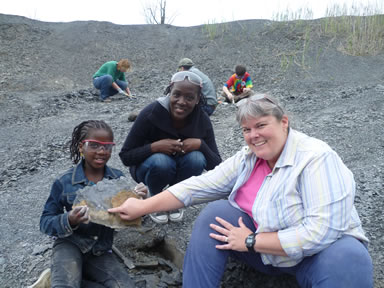Teachers from the New York State Marine Education Association (NYSMEA) packed their knapsacks, not for school, but rather a unique educational outing to explore the stone quarries of Ithaca, New York, in the hunt for trilobites and a visit to the Museum of the Earth.
 It's hard to imagine that for most of the Earth's history, New York State and in fact, most of Northern America, was covered by a warm shallow marine seaway, which left behind a rich fossil record. The sediments of these early seas were later thrust up by plate tectonic events, forming both the mountains of New York and the eastern coast of North America.
It's hard to imagine that for most of the Earth's history, New York State and in fact, most of Northern America, was covered by a warm shallow marine seaway, which left behind a rich fossil record. The sediments of these early seas were later thrust up by plate tectonic events, forming both the mountains of New York and the eastern coast of North America.
Trilobites are extinct invertebrates whose distant living relative today is the horseshoe crab. They resemble pill bugs or insects in that they have segmented bodies and compound eyes. Trilobites seemed to be among the most dominant and widespread group of marine invertebrates during the middle of the Devonian Period, about 360 million years ago. However, trilobites expanded the entire Paleozoic Era, going back to the Cambrian Period, over 500 million years ago.
Trilobites usually inhabited shallow waters, digging themselves into the mud or swimming (although thought to be poor swimmers) close to the bottom. They probably fed on small organisms or dead organic material as scavengers. The back of the trilobite body has a hard carapace that was divided longitudinally into three lobes (hence the name tri-lobe).
With some basic tools in hand, such as hammers, chisels, and safety goggles, we went to work pounding what was once layers of ancient mud that turned into shale over hundreds of millions of years. Although we were determined (and guaranteed) to find trilobites, several other invertebrate fossil specimens were uncovered, including clams, worms, snails, and their traces left as footprint in the mud: wavy trackways, trails, burrows, and borings.

As preparation to our fossil hunt, NYSMEA was invited to the New York Explorer's Club in Manhattan for a presentation on trilobites by Dr. Yumiko Iwasaki, an invertebrate paleontologist from the American Museum of Natural History. We learned about the tools and techniques of fossil collecting in the field and prep work in the lab, in addition to the evolution and morphology of a group of trilobites called phacopids. This group has a unique formation; a big, bulging overhanging stomach in between the compound eyes. I guess it did get enough to eat!
It was wonderful to see one young student and her siblings and parents from St. Ann's School in Brooklyn Heights, join her teacher, Sarah Richards, on this expedition. Our field trips (and membership) are not just for teachers: we like to encourage the total immersion of learning for the entire family.
For more information, visit our website: www.NYSMEA.org for updates on special events, field trips, conferences, professional developments and job opportunities, and internships. Become a member and get marinated!
